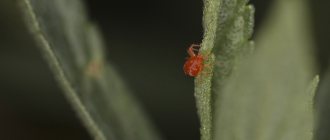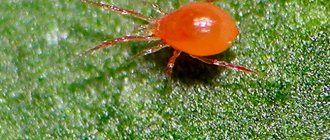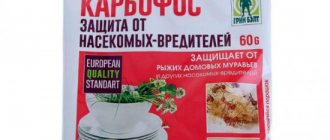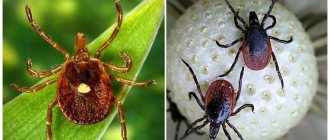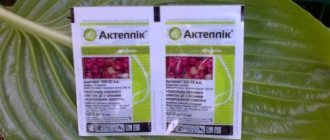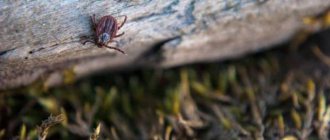Spider mites are an omnivorous pest that affects home plants, garden crops, and even trees. Its presence can be recognized by small light spots on the green parts of the plant and a thin web on the underside of the leaves. You can get rid of spider mites using industrial insecticides or folk remedies.
Spider mites are an omnivorous pest.
Description of the spider mite
It is difficult to see the pest with the naked eye, since its size ranges from 0.2 to 1 mm. Spider mites are herbivorous arthropods that belong to the class of arachnids. Its elongated body is light green, yellow or red, covered with bristles that serve for touch. 8 thin legs end in claws, with the help of which the animal clings to leaves.
Females are larger than males, and their bodies have a more rounded shape. They are capable of laying up to 7 eggs per day, hiding them on the back of the leaves. Future offspring wait out the cold season in cracks in tree bark or fallen leaves. In the egg stage, the pest can survive even in the most severe frosts.
In nature, there are more than 1,300 species of herbivorous web-weaving mites. In Russia, the most common spider mite is the common spider mite, which is polyphagous. The pest is also called strawberry or strawberry pest due to the fact that it is often found on berry crops. It enters a person’s home along with soil, garden tools or particles of earth carried on shoes or clothes.
By sucking out cell sap along with chlorophyll, the mite leaves whitish dots on the leaves.
Numerous spots merge with each other and form large areas of yellow, reddish or brown color. This leads to the leaf drying out and gradually dying. A plant that loses its foliage cannot fully develop and dies.
In addition, constantly moving arthropods spread viruses, gray mold spores and other harmful microorganisms, causing additional damage to the crop.
Appearance (morphology)
Spider mites are very small arachnids, their body length ranges from 0.3 to 1 mm. Adults have the following characteristics:
- two pairs of eyes;
- oval flattened body covered with small hairs;
- palps;
- bristles;
- 8 legs, consisting of 5 segments;
- a piercing device in the form of a massive heart-shaped formation, located in the head area.
The color of a mite depends on its species and the plant it feeds on. The most common are representatives with light green, yellow, brown or bright red color of the cover.
The eggs have the shape of a sphere, flattened towards the poles. The larva has only 6 legs; the nymph looks like an adult animal, but is smaller in size.
Which plants and flowers are susceptible to pest attack?
Spider mites feed on plant cell sap. In spring, the first generations colonize garden weeds - quinoa, nettle, coltsfoot, plantain. By mid-summer, pests move to flower and fruit crops.
Strawberries are susceptible to attack by spider mites.
The following plants are at risk:
- strawberry;
- strawberries;
- raspberries;
- grape;
- currant;
- gooseberry;
- Apple tree;
- pear;
- cucumbers;
- tomatoes;
- eggplant;
- pepper;
- beans;
- roses;
- aster.
The animal also parasitizes house flowers, especially indoor roses.
How to remove spider mites from a greenhouse or greenhouse
Ticks love to live in greenhouses because of the comfortable temperature and abundance of greenery. They get there with purchased seedlings or contaminated soil. The favorable microclimate and limited greenhouse space contribute to the rapid proliferation of parasites, which poses a great threat to the future harvest. Therefore, pest control methods are aimed at the speedy destruction and prevention of re-infestation of greenhouse crops: cucumbers, tomatoes, peppers.
The most accessible and easiest method to destroy parasites is to create for them such living conditions under which they would die naturally.
Spider mites cannot tolerate sudden increases in air humidity: moisture levels of 80-90% are fatal for them. The tick's body is physiologically unable to remove excess water from food. With a long-term “water” diet, pests experience a lack of nutrients and stop reproducing. Greenhouse plants, especially cucumbers, on the contrary, love abundant watering.
If you keep the soil well moistened for 5-7 days, most of the pests will die out.
The following measures will help remove the rest of the population:
- Collecting and burning yellowed leaves or dead plants.
- Application of phosphorus fertilizers to the soil.
- Treating the greenhouse frame and plants with homemade products, such as onion and garlic paste.
- Frequent weeding and loosening of the top layer of soil.
- Irradiation with a UV lamp once a week for 2 minutes.
If the available means do not help, they resort to baiting the parasites with industrial insecticides.
Where are spider mites found?
As mentioned earlier, they easily adapt to different conditions and feed on the sap of a variety of plants. Therefore, you absolutely cannot hope that some flower or conditions will not suit it and it will simply disappear.
But there are conditions that are considered more favorable for their habitat and reproduction. For example, on cucumbers they are more common in greenhouses than in open ground. This can be explained quite simply; the fact is that at temperatures above 25°C they are able to multiply faster. They love warmth and in such conditions the development stages of the pest pass much faster.
Of course, in such favorable conditions, with rapid reproduction, they cause greater damage to crops. When plants are planted very densely, they easily move to new, uninfected bushes. The first signs appear on the leaves, which acquire a brown tint and begin to dry out very much. The ovaries and flowers fall off and if no action is taken, the bush dies.
If we talk about tomatoes, then the situation is even worse. In this case, it is worth mentioning one of the control methods, when crops are subjected to frequent spraying. This method allows you to reduce the number of insects due to increased humidity, which ticks do not tolerate well. But in the case of tomatoes, this method cannot be used, since this crop also does not tolerate moisture well.
Spider mites and indoor plants do not go unnoticed. Here there are simply ideal conditions for them, moderate humidity, warmth, and unhindered access to food. In this case, it is more difficult to fight it, for the reason that at home, most acaricides are prohibited for use. Therefore, it remains to trust biological products that have a high price or use traditional methods.
When berry bushes are infected, there is a risk that pests will be detected very late. When infected, the berries are dropped and the bush stops bearing fruit. A very important step is formative pruning, during which insects can be detected.
They also remain unnoticed on strawberries for a long time, as a result of which the fruits dry out before they have time to ripen, after which the foliage is affected and the bushes die. As a preventive measure, planting material should be dipped in water at a temperature of 60°C for 15 minutes. Watering with the same water in early spring will also help.
Fruit trees are no less interesting than these insects. They can affect absolutely any tree, pear, plum, apple, apricot and others. If you do not take any measures at the initial signs of infection, this will initially lead to loss of harvest, and then to the death of the tree. Of course, they will not be able to cause significant damage in one season, but every year the situation will get worse.
Regarding control methods, the situation is complicated by the fact that large trees are much more difficult to treat. Therefore, during the treatment, some individuals remain untouched, they continue to reproduce and cause harm, as a result of which the tree becomes weaker every year. In addition, a weakened tree is easily susceptible to infection by various diseases.
It is also worth knowing that ticks are not active in early spring. And if, after the sown seeds have sprouted, signs of infection are found, this means that infection occurred from acquired soil or seed, but not from the fact that it overwinters in the soil. Seedlings, unlike adult plants, cannot resist pest attacks and quickly die. Therefore, it is necessary to process the seedlings as soon as possible.
It should be remembered that these mites are not only found on the ground, leaves and stems, they can move throughout the room and hide in hard-to-reach places. This greatly complicates the fight against them and requires more than one procedure.
If thuja, pine or other conifers grow on your site, remember that they are also at risk. When a cobweb is noticed between the needles, measures should be taken immediately.
Regardless of which control method will be used, attention must be paid to feeding. In this case, it is necessary to increase the volume of potassium-phosphorus supplementary feeding, but on the contrary, reduce the volume of nitrogen to a minimum.
In the garden or vegetable garden
On a personal plot, the peak of spider mite activity occurs in July-August. Hot and dry weather contributes to the rapid spread of the pest throughout the entire dacha area.
First, arthropods appear on the first spring weeds - overwintering females lay eggs in nutritious greenery. Therefore, timely weeding and mowing of grass in the garden is a good prevention of further reproduction of ticks.
If a mite is found on strawberries, it is necessary to increase the frequency of watering.
If pests are detected on strawberries, grapes or other crops, the frequency of watering is increased, creating unbearable living conditions for insects. It is advisable to direct a stream of water directly at the plant or bush - this will mechanically remove mites from the foliage. In an open area, it is more difficult to achieve a humidity level above 80% that is harmful to mites, so after watering or spraying the plants, they are covered with film for several hours.
Affected leaves, stems and dead plants are collected and burned to prevent the spread of parasites. Frequent loosening of the soil crust and removal of weeds helps control the mite population. Digging the beds destroys wintering females, so it is advisable to do it annually in the spring and autumn. Adding phosphorus fertilizers to the soil not only has a good effect on the formation of the root system of plants, but also protects them from pests.
If these measures are not enough, they resort to treating plants with industrial insecticidal and acaricidal solutions.
Spider mites: preventive treatment
Protecting and ridding plants of tick-borne parasites involves preventing them from entering the territory of a summer cottage or home. Therefore, preventive measures should include the following actions:
- Removing weeds in open beds and greenhouses.
- Proper feeding of plants to strengthen their immunity against parasites.
- Cleaning up plant residues after harvesting.
- Maintaining the correct temperature and air humidity.
- If necessary, clean the surface of the leaves with a sponge soaked in soapy water and irrigate from the shower.
- Compliance with quarantine for purchased plants in order to identify the possibility of infection.
- Steaming soil substrates for seedlings.
Spider mites are one of the most tenacious and aggressive phytophages. Even one small colony can destroy a large number of plant crops. There are many proven methods to defeat this arachnid parasite. Timely treatment will help save the life of the plant and prevent further spread of the mite.
Use of insectoacaricides
Effective destruction of spider mites can only be achieved by alternating chemicals. This is due to this. that during the season there is a change of several generations of pests, therefore, when using only one insectoacaricide, they develop stable immunity to it. To achieve a lasting result, treatment is carried out 4-5 times with an interval of 5-7 days.
Each subsequent spraying is carried out with a pesticide with a different active ingredient. It is impossible to mix chemicals into one “cocktail”, as this will lead to the emergence of a new generation of pests that are resistant to all components of the poisonous agent.
When working with chemicals, you need to take care of your own safety. Spraying is carried out wearing a respirator and protective gloves. After treatment, the face and hands are washed with soap, work clothes are washed, and the work sprayer is washed several times with a soap-soda solution.
Akarin is used to combat spider mites
The following drugs have proven themselves well in the fight against spider mites:
- “Akarin.”
- "Aktellik".
- “Anti-mite.”
- "Apollo".
- "Iskra-Bio".
- “Kleschevit.”
- "Neoron".
- “Omayt 30”, “Omayt 57”.
- "Tiovit Jet".
- “Etisso.”
The drugs are used according to the attached instructions. It is advisable to use those insectoacaricides that contain a special substance that retains the active substances on plants after rain and dew.
Treatment is carried out in dry, windless weather in the morning or evening hours.
The plantings are generously moistened with the working solution, being careful not to get it on the soil.
How to cure a plant from spider mites?
Physical pest control
Here we are talking about creating favorable conditions for plants: watering, temperature conditions. At the first sign of a spider mite, immediately treat the plant with ultraviolet rays, which destroy the parasites.
Pest control at home:
- — the destruction of spider mites at home begins with washing the leaves and shoots in the shower, thus washing off most of the pests;
- - now we prepare a soap solution from laundry soap and water, using a sponge, treat the leaves on both sides, then the stems. Then rinse with warm water.
- — put a bag on a damp plant, leave it for 24 hours, a humid environment is destructive for spider mites, and under these conditions the remaining parasites will die.
Chemicals to kill spider mites
"Aktellik"
Directions for use: dilute according to instructions, process, cover with a plastic bag to enhance the effect and improve the result.
"Fitoferm"
A chemical preparation made from fungi that are destructive to pests and parasites. After application, it begins to act only on the 3rd day. After one treatment it will not be possible to remove all the larvae, so repeated application will be required.
"Neoron"
A universal drug against all types of ticks, it is capable of destroying pests at any stage of development. Can be used at any air temperature and humidity. After treatment with Neoron, all parasites and their larvae die within a few hours.
"Flumite"
A drug that destroys parasites from larvae to adults.
"Skelta"
A new generation substance that is effective against all stages of tick development.
"Anticlesh"
It is used against different types of ticks; complete destruction will require 2-3 treatments.
Traditional methods of fighting spider mites
Folk remedies, unlike chemicals, are safe for human and animal health. But they are less effective, and, as a rule, are suitable for destroying parasites at the first signs of infection.
"Garlic"
We peel 2 heads of garlic and put them in a 5 liter jar, fill them with water and leave for 5 days. Spray the plants with the prepared infusion.
"Onion"
Onion infusion can be prepared in two ways:
- Method No. 1: pour 100 grams of onion peel with five liters of water and leave for five days.
- Method No. 2: Pour two heads of onions with one liter of boiling water and leave for 24 hours.
Strain the prepared solution, add a liter of water and spray the plant.
"Ammonia"
Add 3 ml of ammonia per liter of water, stir, pour into a sprayer and treat the plants.
"Vodka"
Dilute vodka with water in a 1:1 ratio and wipe the affected leaves and shoots with a cotton pad.
"Dandelion"
You need 30 grams of dandelion roots, finely chop them and add a liter of water. Leave for 24 hours.
"Calendula flowers"
You will need 200 grams of dried or fresh calendula flowers, pour one liter of boiling water. When the water has cooled, strain and treat the plant against spider mites.
"Laundry soap"
Real (72%) laundry soap is the most reliable way to fight parasites. Carefully soap the leaves and stems of the plant and leave for several hours until completely dry. Then rinse off the soap in the shower. Cover with a bag and keep for 2-3 hours.
Fighting spider mites using biological products
Biological means of protecting plantings involve introducing natural enemies to the pests - ladybugs, the predatory phytoseiulus mite, or strains of soil bacteria.
To attract ladybugs to the site, spicy flowers and herbs are planted - calendula, dill, angelica, yarrow, tansy, buckwheat, sweet clover. You can use industrial food for beneficial insects “Wheast”. Ladybugs and their larvae are voracious - they destroy not only herbivorous mites, but also other pests: aphids, whiteflies, scale insects.
The predatory mite phytoseiulus eats adults, larvae, and eggs. It can be purchased in special insectariums - premises for raising beneficial insects. To prevent the appearance of pests, phytosailus is introduced into greenhouses every 14 days in the amount of 5-10 individuals per 1 square meter. m. In case of mass infestation, the number of predators is tripled, and they are populated weekly.
Biotlin is a biological product used to combat spider mites.
Special biological products made using strains and spores of soil bacteria (“Entobacterin”, “Biotlin”, “Fitoverm”, etc.) are also suitable for pest control. These products are safe for humans, animals, birds and beneficial insects. In herbivorous pests, bacterial insecticides cause intestinal toxicosis, leading to their death.
How to get rid of it: methods of struggle
Pest control can be done using proven methods such as::
- chemical;
- biological;
- folk;
- mechanical.
- Folk remedies are one of the most popular methods in the fight against the enemy.. Here are the options you can use to defeat spider mites:
- Garlic – to prepare a solution and spray flowers, you need to mix 20 grams of chopped garlic with 10 liters of filtered water.
- Horseradish – grind the roots and leaves of horseradish in a meat grinder. Leave the resulting mass in water for 60 minutes. Strain the solution and spray in areas where ticks accumulate.
- Cyclamen – boil cyclamen tubers in water for 40 minutes. Leave the prepared solution for a day, strain and spray once every 5 days.
- Tobacco smoke - this method is optimal for those who have smokers at home. The smoke released is harmful to adults, but is useless when affecting eggs.
- Laundry soap solution is ideal for plants with large leaves. To treat in this way, you need to whip up soap foam and lubricate the affected leaves with it. This solution does not destroy the tick, but creates a film in which it cannot breathe and feed.
- Another option to get rid of ticks is to use chemicals.. It is worth remembering here that they are very effective, but at the same time toxic.
When using chemicals, it is necessary to strictly observe safety precautions, namely, use gloves and a mask, isolate the plant from children and animals, and ventilate the room.- "Fitoverm" - destroys larvae and adults, but does not affect laid eggs. The drug is not highly toxic, so the use of a mask and gloves is not necessary. Spraying should be done in an isolated place without access to children and animals.
- "Neoron" - the product destroys not only ticks, but also larvae. After use, it is better to ventilate the room. Process at least three times with an interval of 3–5 days.
- "Sunmite" - this drug is used once every 6 months, as ticks can develop immunity. It is necessary to spray the places where the parasite lives, namely, the lower parts of the plant. The solution is effective only in case of direct contact with the individual or larva.
- The biological method, as one of the ways to combat spider mites , was discovered by Candidate of Biological Sciences G. A. Beglyarov.
Its essence is to feed the parasite to a predator that feeds on ticks. At the moment, there are special bags with predators such as phytoseiulus or amblyseius. It is necessary to hang this device on the plant and open it. The inhabitants living in it immediately begin to hunt for ticks and larvae, eating 2 parasites and a dozen eggs a day. Within a week, all pests will be destroyed, and predators will die two days later due to lack of food. - The mechanical method is very simple . Its essence is that when a lesion is detected, it is necessary to tear off the leaf.
A collection of folk recipes
Folk remedies for spider mites are used at the initial stage of infection or during the fruiting period of crops, when chemicals cannot be used.
The following recipes are most popular among summer residents:
- Soap solution. To prepare the product, 200 g of soap (green, laundry or tar) are grated, diluted in 10 liters of hot water and allowed to cool. The prepared pesticide is generously sprayed onto infected crops once a week, avoiding its contact with the soil. Indoor plants are treated with a sponge dipped in soapy water.
- Infusion of garlic or onion. 30 g of chopped vegetables are poured into 10 liters of boiling water and left in a dark place for 24 hours. An infected garden crop or indoor flower is generously sprayed with the resulting solution several times at intervals of 2-3 days.
- Tobacco decoction. Add 400 g of tobacco or shag to 10 liters of boiling water. The product is boiled over low heat for 20-30 minutes, cooled and left for 24 hours. The finished broth is filtered and diluted with warm water in a ratio of 1:3. Spraying is carried out using a garden sprayer once every 2-3 days.
- Infusion of onion peel. 200 g of onion peels are poured into 10 liters of hot water and placed in a dark place for 1 day. The finished product is filtered and sprayed onto infected crops 1-2 times a week for a month. For indoor plants, wipe the leaves and stems with a decoction.
Affected domestic flowers are isolated from healthy ones. After treatment, the pots with plants are covered with plastic wrap for 2-3 hours, and the trays are scalded with boiling water.
Causes of spider mites
Mites can appear on all plants, including indoor ones. The first signs of a tick infestation may not be obvious and may only appear when there is a large concentration of the pest. The following factors may cause this problem:
- Introducing mites into new plants. Most often, this problem occurs in indoor plants when new flowers purchased from nurseries appear.
- Use of low-quality fertilizers. The larvae can accumulate in humus, which is used to fertilize plants.
- In the garden, insects can be carried by the wind because they are light in weight. In the same way, insects can be carried onto open balconies and loggias.
- Larvae can accumulate on garden tools, so it is necessary to promptly disinfect them.
The mite can also be introduced during sowing of seeds if the planting material is not disinfected in a timely manner.
Prevention of occurrence
Preventive measures should be carried out in advance to prevent the development of the first spring generation.
Greenhouses, greenhouses and other summer cottages in which a tick has been spotted must be treated with copper sulfate or fumigated with a sulfur bomb in spring and autumn.
To exterminate wintering females, deep digging of the beds should be carried out 2 times a year, and the infected tops should be burned.
What else needs to be done to prevent ticks from settling in the area:
- Buy seeds treated with pesticides (they cannot be soaked before planting).
- Maintain the distance recommended by the manufacturer between plantings.
- Loosen the earthen crust and remove weeds in a timely manner.
- Plant herbs in the area that attract ladybugs.
- Apply mineral fertilizers on time.
- Follow the rules of crop rotation.
- Regularly inspect the crop for mite infestation.
To prevent ticks, you need to plant herbs that attract ladybugs.
To prevent infection of indoor plants, after purchase, new specimens are kept in quarantine - a separate room - for up to 2-3 weeks. Before spring replanting, soil brought from the site is heated in the oven to kill parasite eggs. In winter, when the air is dry, spray the plants daily with a spray bottle or wipe the leaves with a damp soft cloth.
Prevention
Remember that it is important not only to cure the flower, but also to prevent the spider mite from settling again. If you purchased a new flower, then you need to place the flower pot away from others, in quarantine, for about 2 weeks. Only after this, after examining him and making sure that there is no threat, can he be placed with the others.
When purchasing soil, it is necessary to carry out disinfection. For this, poison in the form of chemicals is not necessarily used. It is enough to pierce the soil in the oven for 30 minutes at a temperature of 90°C.
Remember that they do not like moisture, and a comfortable level of humidity can be easily maintained by regularly spraying with water from a spray bottle.
Keep it clean and remove dust. But in the open ground, as well as in a greenhouse, it is recommended to plant ordinary dill, which is an excellent preventive measure. Source


